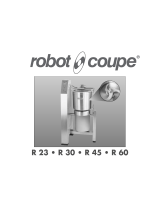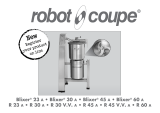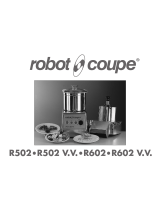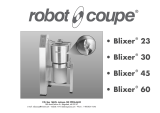Electrolux K353U (601416) Operating instructions
- Category
- Electric food choppers
- Type
- Operating instructions
This manual is also suitable for
Electrolux K353U (601416) is a professional-grade cutter designed for mincing, mixing, emulsifying, liquidizing, and kneading a wide range of food products. Its robust construction and powerful motor make it ideal for commercial kitchens and food processing facilities.
With its versatile rotor system, the Electrolux K353U can handle various tasks, including:
- Mincing meat for terrines, sausages, and beef burgers
- Creating smooth stuffing and mousses
- Mixing butters, mayonnaise, and purées
- Kneading all types of pastries
- Liquidizing shellfish and fish
- Grinding breadcrumbs and almonds
Electrolux K353U (601416) is a professional-grade cutter designed for mincing, mixing, emulsifying, liquidizing, and kneading a wide range of food products. Its robust construction and powerful motor make it ideal for commercial kitchens and food processing facilities.
With its versatile rotor system, the Electrolux K353U can handle various tasks, including:
- Mincing meat for terrines, sausages, and beef burgers
- Creating smooth stuffing and mousses
- Mixing butters, mayonnaise, and purées
- Kneading all types of pastries
- Liquidizing shellfish and fish
- Grinding breadcrumbs and almonds






-
 1
1
-
 2
2
-
 3
3
-
 4
4
-
 5
5
-
 6
6
Electrolux K353U (601416) Operating instructions
- Category
- Electric food choppers
- Type
- Operating instructions
- This manual is also suitable for
Electrolux K353U (601416) is a professional-grade cutter designed for mincing, mixing, emulsifying, liquidizing, and kneading a wide range of food products. Its robust construction and powerful motor make it ideal for commercial kitchens and food processing facilities.
With its versatile rotor system, the Electrolux K353U can handle various tasks, including:
- Mincing meat for terrines, sausages, and beef burgers
- Creating smooth stuffing and mousses
- Mixing butters, mayonnaise, and purées
- Kneading all types of pastries
- Liquidizing shellfish and fish
- Grinding breadcrumbs and almonds
Ask a question and I''ll find the answer in the document
Finding information in a document is now easier with AI
Related papers
-
Electrolux K25XU (601413) Operating instructions
-
Electrolux K180FU (603302) Operating instructions
-
Electrolux DITO K353 User manual
-
Electrolux K180F385 User manual
-
Electrolux KE180F User manual
-
Electrolux K35U User manual
-
Electrolux 603308 User manual
-
Electrolux K120F4 User manual
-
Electrolux TRK55VVU (603344) Operating instructions
-
Electrolux MUGU (601411) Operating instructions
Other documents
-
 Robot Coupe R23 User manual
Robot Coupe R23 User manual
-
 Robot Coupe R 30 Owner's manual
Robot Coupe R 30 Owner's manual
-
Robot Coupe R 20 User manual
-
Cuisinart Brew Central DCC-1200 Series Instructions Manual
-
Robot Coupe R 20 Operating Instructions Manual
-
Moulinex ODACIO FP723 User manual
-
Robot Coupe R 20 Instructions of use
-
Moulinex ODACIO Owner's manual
-
 Robot Coupe R502 User manual
Robot Coupe R502 User manual
-
 Robot Coupe Blixer 23 Operating instructions
Robot Coupe Blixer 23 Operating instructions









